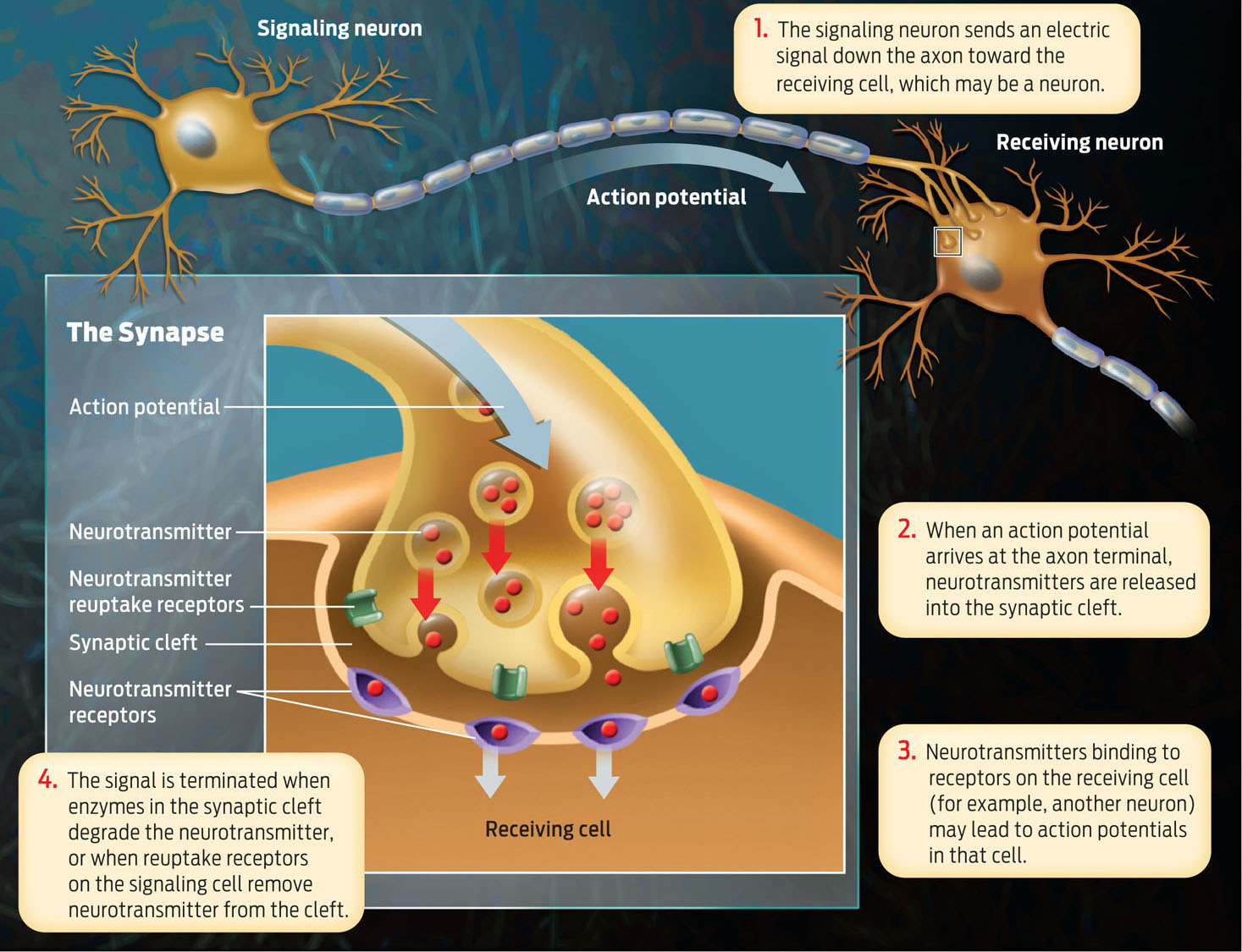CHEMICAL MESSENGERS
NEUROTRANSMITTER A chemical signaling molecule released by a neuron to transmit a signal to a neighboring cell.
For Ward, who turned 40 in 2013, it wasn’t just the smoking at the weekly poker game that rekindled his desire to smoke, it was a combination of events. For one thing, he says he was “extremely stressed” about work. He had started working as a freelance writer, and he was having trouble juggling his deadlines. In the past, he would often rely on smoking to calm himself. “I’m a nervous worker,” he says. “Some people shake their legs, or pace, or exercise to work off stress. For me it was smoking.” And then a difficult family situation arose. Up to that point, he had managed to avoid smoking, even in the presence of smokers, because, he says, he had learned to think of himself as a nonsmoker: holding to that self-concept was a way to persuade himself not to pick up a cigarette. But in the end, the combination of stressful events and easy access to cigarettes pushed him to smoke again.
SYNAPSE The site of transmission of a signal between a neuron and another cell; the synapse includes the axon terminal of the signaling neuron, the space between the cells, and receptors on the receiving cell.
As he took a long-awaited drag, the dopamine released by neurons in the VTA excited neurons in the pleasure center of his brain. Dopamine is one type of chemical messenger, or neurotransmitter, that cells of the nervous system use to communicate with one another, and with other cells such as muscles. Neurotransmitters are chemical signals released by neurons at the end of their axons when an action potential reaches the tip of the axon. These chemical signals transmit information to another cell. The site of transmission of a signal from a neuron to another cell is called the synapse, which consists of the axon terminal, a small gap between the two cells, and receptors on the receiving cell.
SYNAPTIC CLEFT The physical space between a neuron and the cell with which it is communicating.
When the electrical signal of an action potential reaches a neuron’s axon terminal, it stimulates the neuron to release neurotransmitters from its axon terminal into the space between the neuron and the cell with which it is communicating. Neurotransmitters diffuse across this space, called the synaptic cleft, to carry messages from one cell to another. Each neurotransmitter fits into a receptor on the surface of the cell receiving the signal as a key fits into a lock. The act of a neurotransmitter binding to its receptor initiates a response in the receiving cell. If the receiving cell is another neuron, the binding of neurotransmitter may spark another action potential, thereby perpetuating the signal. Signaling between the two cells is terminated when the neurotransmitter is removed from the cleft. Neurotransmitter may be degraded by enzymes in the synaptic cleft, or taken back up into the signaling neuron via reuptake receptors (INFOGRAPHIC 29.6).
Within a neuron, action potentials are electrical signals that carry information. When an action potential reaches the axon terminal, a neuron releases molecules called neurotransmitters that communicate with the next cell in the pathway at a synapse.

Cells in the nervous system use several different neurotransmitters to communicate different messages. For example, the neurotransmitter serotonin, which is active in the CNS and the gastrointestinal tract, regulates anxiety, appetite, and sleep. Another important neurotransmitter is acetylcholine, which is involved in learning, memory, and muscle contraction.
Many drugs–including both drugs of abuse and therapeutic medicines–interact with neurotransmitters. The class of antidepressant drugs known as selective serotonin reuptake inhibitors (SSRIs), which includes Prozac and Zoloft, helps to treat depression by preventing the reuptake of serotonin from the synaptic cleft, thus prolonging the activity of this mood-elevating neurotransmitter. Nicotine binds to receptors on neurons and triggers the release of multiple neurotransmitters in the brain, which accounts for the range of sensations that smokers experience: a reduction in anxiety, for instance, as well as an increased ability to concentrate. And nicotine dramatically increases the release of dopamine from certain neurons.